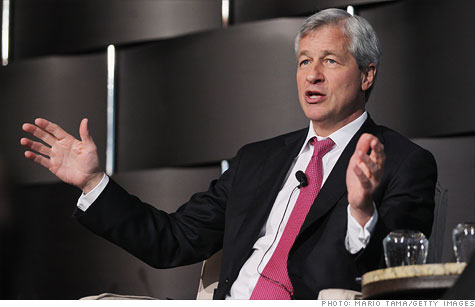
While serving as the head of JPMorgan Chase, Jamie Dimon has also sat on the New York Fed's board of directors. Seem shady? Blame Congress.
NEW YORK (CNNMoney) -- Is there a conflict of interest when bankers like JPMorgan Chase CEO Jamie Dimon serve on the board of the same institution that regulates them?
Insiders say no. But critics harp on the central bank for what seems like an incestuous relationship with Wall Street.
Massachusetts Senate candidate Elizabeth Warren called for Dimon's resignation from the New York Fed's board last week, and Sen. Bernie Sanders has used the uproar to promote the idea of overhauling the Federal Reserve.
"The conflicts of interest are so apparent that they're laughable," Sanders told CNN's Wolf Blitzer last week. "Here you have the Fed, which is supposed to regulate Wall Street. Then you have the CEO of the largest Wall Street company on the board which [it] is supposed to be regulating. This is the fox guarding the henhouse."
Dimon served on the New York Fed's board of directors amid the financial crisis. Appointed to the post initially in 2007, he is scheduled to end his second three-year term in December. He is currently the only executive of a major national bank to serve on a regional board.
If it seems shady though, don't blame the Fed. Congress intentionally set the central bank up that way in 1913.
The Federal Reserve Act, which created the central bank, was a controversial measure back then. In a political move designed to get the bill passed, Congress decided to include bankers on the regional boards.
"There was a tremendous amount of opposition. The bankers were terribly offended by the idea that a central bank would regulate them," said Elmus Wicker, professor emeritus at Indiana University, who has written five books about the history of the Fed.
In an attempt to decentralize the institution away from just Washington and New York, the law divided the Fed into 12 regional banks. Each are led by a president and a board of directors with nine members.
The law requires that three of those nine members, dubbed "Class A" directors, are bankers from the region. The other six must represent the public, particularly in the interests of agriculture, commerce, industry, services, labor and consumers.
The central bank's most influential branch is undeniably the New York Fed, which sits just blocks away from Wall Street.
There, Dimon sits on the board along with CEOs from Banco Popular de Puerto Rico and Solvay Bank, a small regional bank based near Syracuse, N.Y. The heads of Macy's (M, Fortune 500), the Metropolitan Museum of Art and Columbia University are also on the board.
The board members typically meet twice a month and are paid a bit for the job -- about $5,000 a year for the chairman and $2,000 for the others. Their responsibilities include overseeing the management of the New York Fed, contributing their insight on the economy, and acting as a link between the government and private sector.
However, they have no say over the Fed's supervisory or regulatory role.
It's "not like a board, it's more of an advisory group," Dimon explained to JPMorgan Chase (JPM, Fortune 500) shareholders at the bank's annual investor meeting in Tampa, Fla. last week. "I am not involved at all in the supervisory side of that."
That distinction was not enough to satisfy government investigators last year though, who chided the Federal Reserve's regional banks for failing to clearly document the roles and responsibilities of their directors.
A report by the Government Accountability Office cited a case where then-chairman of the New York Fed's board of directors Stephen Friedman owned shares in Goldman Sachs (GS, Fortune 500) -- one of many banks to benefit from the Wall Street bailouts.
Friedman was granted a waiver in January 2009, but the board was unaware that he had purchased additional shares in Goldman Sachs through an automatic stock purchase program. He later resigned from the board.
While the GAO report did not identify actual conflicts of interest, it indicated the appearance of a conflict could hurt the credibility of the Fed.
Treasury Secretary Timothy Geithner echoed those concerns last week following the JPMorgan Chase uproar. In an interview with the PBS NewsHour, he admitted that bankers on the board create a public relations nightmare for the central bank.
"The perception is a problem," Geithner told PBS NewsHour. "And it's worth trying to figure out how to fix that." ![]()
| Overnight Avg Rate | Latest | Change | Last Week |
|---|---|---|---|
| 30 yr fixed | 3.80% | 3.88% | |
| 15 yr fixed | 3.20% | 3.23% | |
| 5/1 ARM | 3.84% | 3.88% | |
| 30 yr refi | 3.82% | 3.93% | |
| 15 yr refi | 3.20% | 3.23% |
Today's featured rates:
| Latest Report | Next Update |
|---|---|
| Home prices | Aug 28 |
| Consumer confidence | Aug 28 |
| GDP | Aug 29 |
| Manufacturing (ISM) | Sept 4 |
| Jobs | Sept 7 |
| Inflation (CPI) | Sept 14 |
| Retail sales | Sept 14 |